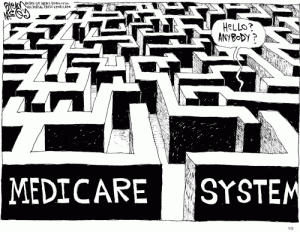By Jack Cumming
Tax-exempt senior living providers grapple with a capital challenge. They don’t have access to the equity markets. The result is that entrance fees have long been central to the nonprofit senior living financing model. Most business-minded residents in nonprofit senior living for the affluent have assumed that entrance fees were a prepayment of their own future services. Many provider organizations, paradoxically, have viewed entrance fees as tantamount to the down payment that homeowners ante up when they buy a house with a mortgage. The question is whether tax exemption is worth this resident deception.
Reasonable Resident Concerns
This disconnect has been the subject of recent correspondence I’ve been embroiled in lately with concerned residents from several different parts of the country. These residents view themselves as participants in the nonprofit enterprises that house them. This is similar to the way that policyholders in mutual insurance companies participate in those enterprises.
Resident entrance fees are the source for equity capitalization in nonprofit businesses that lack sufficient retained earnings. So, it’s not surprising that business-wise residents grow wary when those entrance fees are used to fund speculative expansion. It can be disconcerting for executives, who believe that their nonprofit service should not be questioned, to have residents asking pointed questions about expansion. Of course, most executives reason, growth through expansion is essential for a healthy enterprise. We can also, they reason, advance our mission on behalf of seniors by serving more of them.
Commendable Operators
Most of the nonprofit enterprises causing these activist resident concerns are well-managed by the norms that prevail in the nonprofit sector of the senior living industry. One of the enterprises prides itself on its turnaround story from a situation in which “entrance fees [were] used to subsidize operations, creating a negative net operating income.” Then, “competition entered the marketplace, pushing . . . strategic decisions to avert potential loss of market share.”
Despite the challenges of the 2008 recession, this management spruced up the property to be more attractive, increased revenue, realigned operations to save expense, and made departments financially accountable. Many industry operators can learn from that positive story. Imagine accomplishing all that during the great economic downturn. No wonder management is proud of its accomplishment. They should be proud.
Today, that original property has a strong, positive balance sheet. If the enterprise were investor-funded, there would be no controversy. But it’s not funded by investors. It’s a nonprofit. It’s tax-exempt. Its historical operations have been funded by those entrance fees. These thoughtful residents expect that their investment should give them a strong voice. In deciding how much to invest in expansion, whether the pace of planned expansion is wise, and other decisions from which residents are typically excluded.
The Quest for Alternatives
Whether you, as a reader who cares about senior living, agree with the residents or think that the executives and their boards should have free rein, the buzz that resident discontent, mild though it may be, generates can hurt sales and marketing. It creates a perception issue that should be thoughtfully considered in a quest for alternatives.
What might those alternatives be? First is the possibility of persuading state legislators to enact guaranty legislation like that of the insurance industry so residents wouldn’t have to fear the risky investment of their entrance fees. This possibility has been largely ignored by the industry trade associations. Pensions, bank deposits, securities accounts, and insurance are all protected but not entrance fee investments. The National Organization of Life and Health Insurance Guaranty Associations is the enabling organization for the insurance model which is the one that would be the least disruptive for senior living.
A second path is consolidation, which is receiving much attention of late. The idea is that there are economies with size. Those economies are much more difficult to accomplish with nonprofits than with for-profits. Since nonprofits can only be merged with the consent of the merging organizations, agreements often grandfather in redundant jobs that would be quickly eliminated in the case of an investor takeover of a for-profit enterprise. That may be good for those whose jobs are preserved but it increases costs for those the enterprise serves and it impedes innovation.
The third path is the one that many of the large, nationwide mutual insurance companies have pursued. They have converted to investor-owned enterprises to get the advantage of access to equity capital. Using true equity capital to fund expansion and growth is far more defensible than diverting resident fees for that purpose.
Corporate Conversion
There are many advantages for residents and prospective residents as nonprofits convert to investor-funded, taxpaying organizations. In addition to access to equity capital, for-profits benefit from the faster pace that is typically associated with thriving, growing corporations. It’s not surprising that the nonprofits were seen as more heroic in their response to the pandemic. There is a public perception that nonprofits are less greedy. Their focus is on caregiving rather than on finances.
Still, their for-profit peers were able quickly to arrange a lab to test all residents, as Juniper Communities did, or to bring in trailers to house volunteer employees on-site, as Tyson Belanger did, spending his own money to protect his residents. That pace of action is typically for-profit. These stories of for-profit responsiveness abound, and they, too, are heroic.
It’s time for the financial interests – tax-exempt investment banking advisors, nonprofit-focused accounting firms, and senior living development consultants – to rethink whether tax exemption is worth the price that it demands in integrity. That commitment to integrity is in question when entrance fees are diverted toward corporate ventures or when negative net asset balance sheets are tolerated as being of no concern.
These same firms that depend on, and perpetuate, today’s use of entrance fees as at-risk investments can reinvent themselves to prosper in leading a trend toward conversion. Moving to investor-funded operations does not mean that “nonprofit principles” are abandoned or that executives are less dedicated to the mission. For instance, compensation for CEOs can be comparable to that of the President of the United States, including living quarters on site. The structure and responsibilities of U. S. Cabinet members also provide a metric.
The investment bankers can devise new financing instruments. We can imagine, for example, convertible equity notes that become debt once the corporation achieves an acceptable level of retained earnings. Other equity financing tools might function like preferred stock but callable once the organization achieves financial strength. Investment bankers for senior living nonprofits have long been creative as when Joan Annett devised the contingent refund instrument.
With investor-funded, taxpaying organizations, it’s clear that the owners are the investors. The investors sign up for the risk inherent in taking the equity position to secure the debt. That’s not what the residents sign up for when they accept the contract terms put forward by ostensibly nonprofit operators. It’s time to rethink the financial underpinnings of the business and to consider whether the providers should instruct their trade associations to lead the way toward a more sustainable structure.
Special Interest History
In closing, we should note that there’s a history to explain how senior living came to embrace nonprofit organization for housing affluent elders. At one time, nonprofit senior living was “charitable” in the everyday sense of that word. That charitable concept, in which residents paid less than the cost of their care with the rest made up by philanthropy, ended during the Nixon administration in 1972. That was when a Hanson Bridgett partner, acting on behalf of the industry, persuaded the IRS to issue Revenue Ruling 72-124. That ruling declared that the “distress” of aging was enough in and of itself to qualify an enterprise as charitable if it relieved such “distress.”
With the stroke of that pen, nonprofits were allowed to supplement their offerings for indigents with luxury housing for the affluent. They sold continuing care contracts that required entrance fees as part of the contractual consideration. This led to conflicting perceptions between provider executives, who saw opportunity, and residents who paid for lifelong protection.
Aging has changed dramatically since 1972. Not only have we added years to life, but we have added years of independent function. Aging today is nothing like what it was then when “distress” was plausible. It’s time to question whether age-related distress, in and of itself, is still enough to justify subsidizing elder housing for the affluent through tax exemption.
Click here to read comments and join the conversation about this article.








